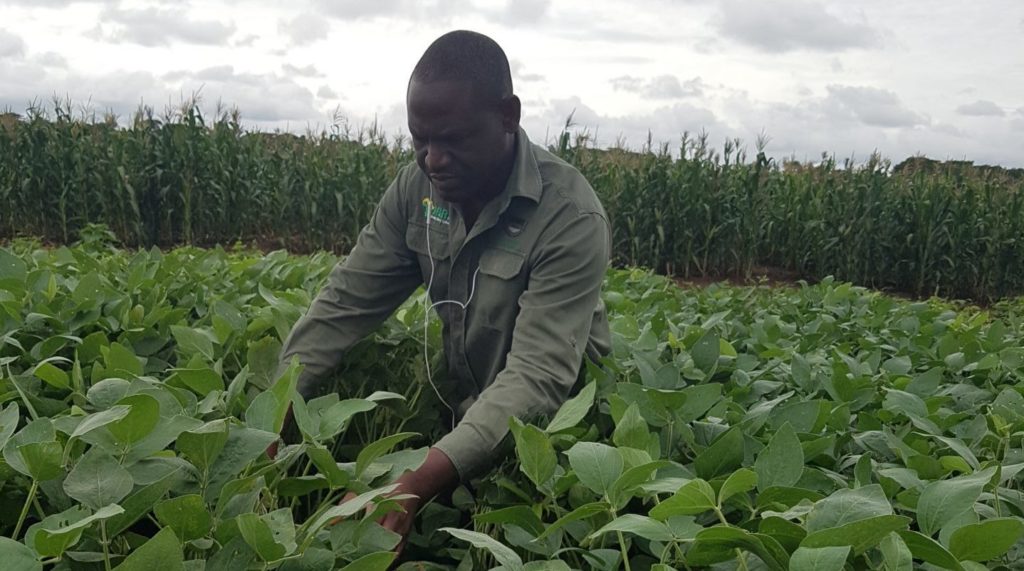By Mantoe Phakathi
Ndashe Kapulu, is a doctoral researcher at the University of Leeds, in the UK. He also works for the Ministry of Agriculture in Zambia. Through his research study supported by AFRICAP, he is investigating how diversifying into soybean production will impact livelihoods and food security of smallholder households in Zambia, where maize production is a staple. The GCRF-AFRICAP programme is supporting researchers to generate evidence in Malawi, South Africa, Tanzania and Zambia, to inform policy development in agriculture and food security.
How did the research on the diversification to soybean come about in Zambia?
Soybean was prioritised as an alternative crop in Zambia following a multi-stakeholder consultative meeting. Stakeholders felt that, within the government’s crop diversification agenda, soybean had a potential of improving the income of commercial and small-scale farmers.
To underpin that, the government set up a technical working group to understand the potential of edible oils to which soybean ranked highly. The GCRF-AFRICAP programme, through the Agricultural Consultative Forum (ACF), has made a lot of progress in planning for a Soybean Strategy. ACF is facilitating a platform to generate evidence within Zambia to inform the government on how best they can support the commercialisation of soybean, among other crops.

What is your research about?
I am trying to understand how emerging soybean markets in Zambia have implications on food security and incomes of rural smallholder households. What are the implications of diversifying to soybean production from maize on the livelihoods and food security of the rural smallholder households?
Soybean was initially mainly grown by commercial farmers from around the mid-1980s until 2005, when much of the market was opened up. Several multinational companies set up processing plants within the country. As a result, there was an upsurge of soybean production in Zambia.
From 2005 to date, we have seen an exponential increase in the participation of smallholder farmers in the soybean value chain. However, there is very little evidence to understand how their participation in this value chain has impacted on their livelihoods, income and food security, hence the focus of this research.
What is the progress of your research so far?
We are still in the early stages of our research. We conducted a rural household survey in May 2019 on smallholder farmers living in predominantly soybean production areas, mainly Central Province and now Eastern Province. We concentrated on the Central Province, Mkushi and Chibombo districts which are unique.
On the one hand, Mkushi is predominantly a farming block with a lot of commercial farms that grow, among other things, soybean, alongside wheat and beans. The district also has a lot of small-scale settlements around those commercial farming blocks.
On the other hand, Chibombo is predominantly a small-scale farming setting but it is located close to Lusaka, the capital city, which is where most of the soybean output markets are found. Within the district, there is a big multinational company with a huge crushing plant and it offers out-grower schemes to small-scale farmers.
So, using those two market access dynamics, we decided to conduct this research to understand how proximity to markets for soybean would impact on farmer participation. We are also trying to understand how the proximity to large commercial operations will impact on smallholder farmers in terms of their participation in soybean processing as well as their access to inputs, incomes and livelihoods in general.
Is soybean part of the Climate-Smart Agriculture (CSA) technology?
Yes. One of the key messages that led to the promotion of soybean by the government and NGOs is that, as a legume, it is a low-input crop compared to maize.
Most legumes can have their seeds recycled without losing their germination vigour. Farmers can save seed from the previous harvest and replant it, whereas in maize one needs to buy a fresh supply of seed every season.
One of the things that the government and NGOs have promoted is the use of inoculums, which are Rhizobium bacteria that help soybean generate nitrogen through biological means. That means there is no need for external nitrogen. Farmers have been encouraged to grow soybean in rotation with cereals such as maize to enhance soil fertility. Another aspect, to some extent, is that soybean is more drought resilient compared to maize.
Within the GCRF-AFRICAP programme we have done a model which projects that in the next 20 to 30 years, Africa will be dominated by soybean production because of the way the climate will evolve. The climate will suit the growing of soybean. Most of the workers within the CSA space are promoting it on that perspective.
How has the growth of smallholder farmers evolved since the government prioritised soybean?
From 2005, 85 percent of the land area and production was under commercial farming, but recent statistics show that now 60 percent of soybean production is coming from commercial farmers. The land area production under soybean has changed to nearly 70 percent under small scale and 30 percent under commercial. However, commercial farmers are able to get more yields compared to their small-scale counterparts because of better access to quality seeds and other inputs.
